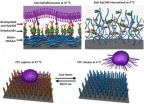(Press-News.org) A new study published by University of Chicago researchers challenges the notion that the force of an exploding star forced the formation of the solar system.
In this study, published online last month in Earth and Planetary Science Letters, authors Haolan Tang and Nicolas Dauphas found the radioactive isotope iron 60 — the telltale sign of an exploding star—low in abundance and well mixed in solar system material. As cosmochemists, they look for remnants of stellar explosions in meteorites to help determine the conditions under which the solar system formed.
Some remnants are radioactive isotopes: unstable, energetic atoms that decay over time. Scientists in the past decade have found high amounts of the radioactive isotope iron 60 in early solar system materials. "If you have iron 60 in high abundance in the solar system, that's a 'smoking gun'—evidence for the presence of a supernova," said Dauphas, professor in geophysical sciences.
Iron 60 can only originate from a supernova, so scientists have tried to explain this apparent abundance by suggesting that a supernova occurred nearby, spreading the isotope through the explosion.
But Tang and Dauphas' results were different from previous work: They discovered that levels of iron 60 were uniform and low in early solar system material. They arrived at these conclusions by testing meteorite samples. To measure iron 60's abundance, they looked at the same materials that previous researchers had worked on, but used a different, more precise approach that yielded evidence of very low iron 60.
Previous methods kept the meteorite samples intact and did not remove impurities completely, which may have led to greater errors in measurement. Tang and Dauphas' approach, however, required that they "digest" their meteorite samples into solution before measurement, which allowed them to thoroughly remove the impurities.
This process ultimately produced results with much smaller errors. "Haolan has dedicated five years of very hard work to reach these conclusions, so we did not make those claims lightly. We've been extremely careful to reach a point where we're ready to go public on those measurements," Dauphas said.
To address whether iron 60 was widely distributed, Tang and Dauphas looked at another isotope of iron, iron 58. Supernovae produce both isotopes by the same processes, so they were able to trace the distribution of iron 60 by measuring the distribution of iron 58.
"The two isotopes act like inseparable twins: Once we knew where iron 58 was, we knew iron 60 couldn't be very far away," Dauphas explained.
They found little variation of iron 58 in their measurements of various meteorite samples, which confirmed their conclusion that iron 60 was uniformly distributed. To account for their unprecedented findings, Tang and Dauphas suggest that the low levels of iron 60 probably came from the long-term accumulation of iron 60 in the interstellar medium from the ashes of countless stars past, instead of a nearby cataclysmic event like a supernova.
If this is true, Dauphas said, there is then "no need to invoke any nearby star to make iron 60." However, it is more difficult to account for the high abundance of aluminum 26, which implies the presence of a nearby star.
Instead of explaining this abundance by supernova, Tang and Dauphas propose that a massive star (perhaps more than 20 times the mass of the sun) sheds its gaseous outer layers through winds, spreading aluminum 26 and contaminating the material that would eventually form the solar system, while iron 60 remained locked inside the massive star's interior. If the solar system formed from this material, this alternate scenario would account for the abundances of both isotopes.
"In the future, this study must be considered when people build their story about solar system origin and formation," Tang said. — Chelsea Leu
INFORMATION:
Citation: "Abundance distribution, and origin of 60Fe in the solar protoplanetary disk," by Haolan Tang and Nicolas Dauphas, Earth and Planetary Science Letters, December 2012.
Funding: National Aeronautics and Space Administration, National Science Foundation, and the Packard Foundation.
Exploding star missing from formation of solar system
2012-12-17
ELSE PRESS RELEASES FROM THIS DATE:
JCI early table of contents for Dec. 17, 2012
2012-12-17
Harnessing the ID in glioma
Gliomas are the most common form of brain tumor. They are highly aggressive and effective treatments are not currently available. The tumors contain glioma initiating cells (GICs), a population that is highly similar to neural stem cells. GICs drive tumor progression and must stay in a particular extracellular niche in order to maintain their cancer-promoting, stem cell-like characteristics. In this issue of the Journal of Clinical Investigation, researchers led by Antonio Iavarone at Columbia University report on the role of ID proteins in ...
Harnessing the ID in glioma
2012-12-17
Gliomas are the most common form of brain tumor. They are highly aggressive and effective treatments are not currently available. The tumors contain glioma initiating cells (GICs), a population that is highly similar to neural stem cells. GICs drive tumor progression and must stay in a particular extracellular niche in order to maintain their cancer-promoting, stem cell-like characteristics.
In this issue of the Journal of Clinical Investigation, researchers led by Antonio Iavarone at Columbia University report on the role of ID proteins in glioma. ID proteins allow ...
Physicians should not prescribe ADD drugs to healthy people
2012-12-17
Physicians in Canada should consider refusing to prescribe cognitive enhancement medications — also used to treat attention deficit disorder (ADD) — to healthy patients, states an analysis article in CMAJ (Canadian Medical Association Journal). Lack of evidence for benefits and possibility of harm, limited health care resources and professional integrity of physicians are reasons why this use is not acceptable.
Prescription stimulants such as methylphenidate and dextroamphetamine are often used by people for "cognitive enhancement" to increase focus, concentration and ...
Rationing soft drink sizes: A good public health move
2012-12-17
New York City's limit of a maximum 16-ounce size of sugar-sweetened drinks for sale in eating establishments is a positive public health move and should be replicated in Canada, argues an editorial in CMAJ (Canadian Medical Association Journal).
"Because sugary drinks are the leading source of dietary calories in North America, New York City's latest measure is a rational strategy to combat obesity on a population level," writes Dr. Matthew Stanbrook, Deputy Editor, Practice, CMAJ. "The scientific case for reducing sugar consumption is stronger than ever. Recent evidence ...
New technology allows scientists to capture and preserve cancer cells circulating in the bloodstream
2012-12-17
Scientists from the RIKEN Advanced Science Institute in Japan and University of California Los Angeles report a new nanoscale Velcro-like device that captures and releases tumor cells that have broken away from primary tumors and are circulating in the bloodstream.This new nanotechnology could be used for cancer diagnosis and give insight into the mechanisms of how cancer spreads throughout the body. The device provides a convenient and non-invasive alternative to biopsy, the current method for diagnosis of metastatic cancer. It could enable doctors to detect tumor cells ...
Surviving sepsis with LECT2
2012-12-17
Failure to launch an adequate immune response may be at the root of septic shock, according to a study published in The Journal of Experimental Medicine on December 17th.
Bacterial sepsis is a potentially deadly blood infection that results in massive immune activation and inflammation. Sepsis therapies have traditionally focused on quelling this exaggerated inflammatory response. But a recent study challenged this approach by showing that patients with sepsis had abnormally low levels of an inflammatory protein called LECT2.
The new study by Jiong Chen and colleagues ...
Study uncovers mechanism used by BRCA1 to suppress tumors
2012-12-17
WASHINGTON -- A new study by Georgetown University Medical Center researchers reveals how a well-known tumor suppressor gene may be functioning to stop cancer cell growth.
The findings, published online today in Oncogene, focus on the gene BRCA1, which is mutated in a majority of families who have hereditary breast and/or ovarian cancers, according to senior author Ronit I. Yarden, PhD, assistant professor in the Department of Human Science at the School of Nursing & Health Studies.
"There is a debate in the scientific community about whether BRCA1 enzymatic activity ...
New research predicts rising trend in India's Violent Land Conflicts; 130 districts struggle
2012-12-17
Contact: Jenna DiPaolo
jdipaolo@rightsandresources.org
202-412-0331
Coimbra Sirica
csirica@burnesscommunications.com
301-943-3287
Burness Communications
New research predicts rising trend in India's Violent Land Conflicts; 130 districts struggle
Experts cite role of India as leader among land-grabbing emerging economies; ignoring rights at home, Indian multi-nationals risk same mistakes abroad
NEW DELHI—(17 December 2012)—New research released today, on the eve of an international conference on land and forest rights, blames India's government agencies and ...
Cats are able to navigate complex combinations of wet and dry foods to achieve a consistent intake of protein, fat and carbohydrate
2012-12-17
Even when provided with complex combinations of different wet and dry foods, cats are able to select and combine the foods in different amounts to achieve a consistent intake of protein, fat and carbohydrate, i.e. macronutrient intake. Published this month in the Journal of Comparative Physiology B, the research shows that cats regulate their macronutrient intake by altering their food selection despite differences in the macronutrient content, moisture level and texture of foods.
The research was conducted by scientists from the WALTHAM® Centre for Pet Nutrition – the ...
Brain imaging identifies bipolar disorder risk in adolescents
2012-12-17
Researchers from the University of New South Wales and Black Dog Institute in Sydney, Australia have used brain imaging technology to show that young people with a known risk of bipolar (but as yet have no signs of the condition) have clear and quantifiable differences in brain activity when compared to controls.
"We found that the young people who had a parent or sibling with bipolar disorder had reduced brain responses to emotive faces, particularly a fearful face. This is an extremely promising breakthrough," says study leader UNSW Professor Philip Mitchell.
"We ...

